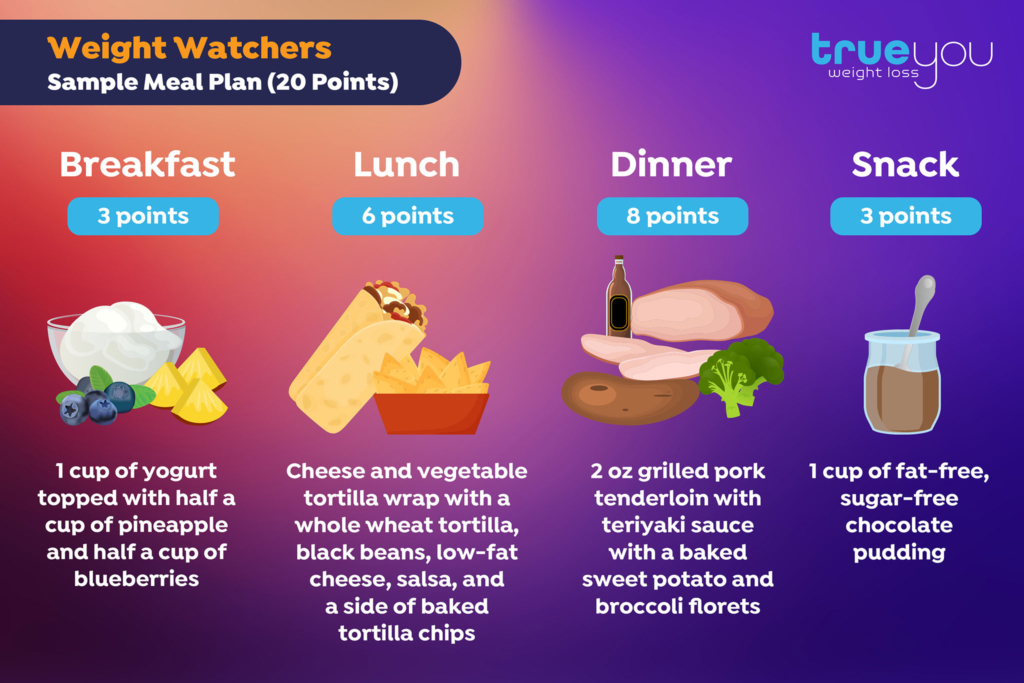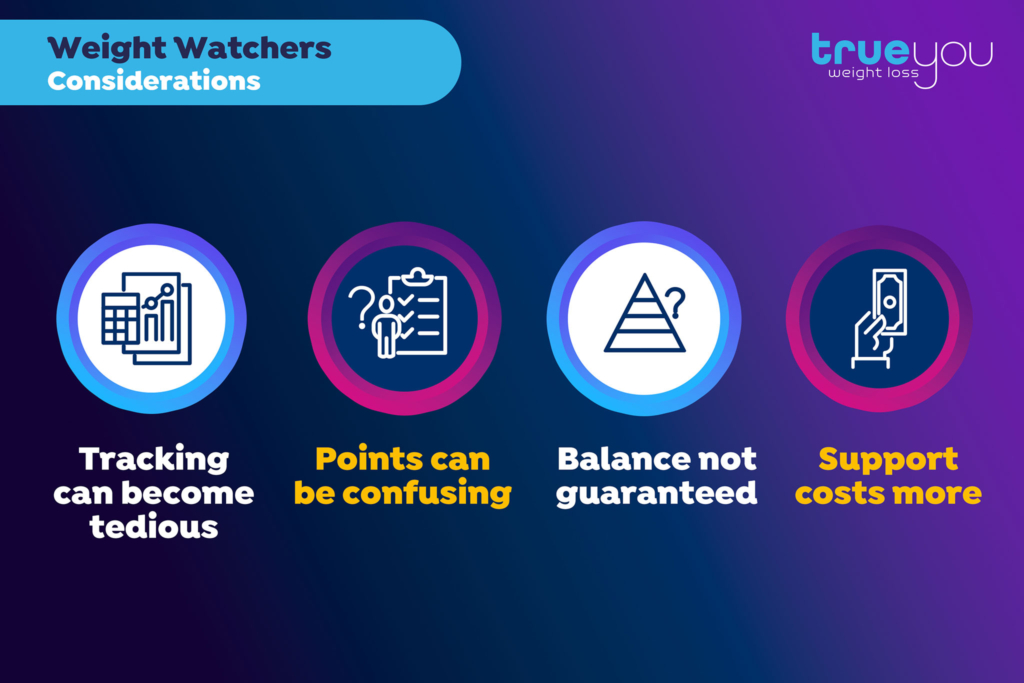WW Origin | How Does WW Work? | WW Meal Plan | WW Weight Loss | Negatives of WW | What Do The Experts Say | WW Bottom Line | True You Weight Loss
The decision to start a weight loss journey doesn’t usually come easily, and most people either have to think about it for a while or wait for the “right” moment to present itself. This decision-making process also usually involves a lot of research and reflection. Which diet is right for me? How much weight do I need to lose? Will I be able to stick with it? And it’s this often convoluted and daunting process that leads to fad diets that promise amazing results with limited effort.
Choosing a weight loss program among numerous options is understandably difficult, and for that reason many people look to systems that seem tried-and-true. A classic example of this kind of diet that has been around for decades is Weight Watchers. With over four million members, it is one of the most popular diets in the world. In fact, U.S. News & World Report has named it the “Best Diet for Weight Loss” for nine years in a row. But with all the hype, does it actually work for weight loss?
The Weight Watchers diet program was originally conceived by a housewife from New York named Jean Nidetch. By 1961, Nidetch was in her late 30s and had been overweight for most of her adult life. After trying a 10-week weight management program sponsored by a New York obesity clinic, she was able to lose weight but found that the program was lacking in providing the kind of intangible emotional support she needed to sustain her progress. To make up for this, she decided to start her own support group with other women living in her apartment.
What began as a small support group eventually grew into a loose network of groups in other neighborhoods nearby that included both women and men. One couple, Al and Felice Lippert, convinced Nidetch to turn the effort into a business so it could help even more people. In 1963, Nidetch and the Lipperts founded Weight Watchers Inc. For $2 a session, people could come to a weekly support group meeting and get encouragement, inspiration, and ideas for how to stick with the plan.
Over the following decades, the company continued to grow and evolve as ownership changed hands several times. Along the way, the original mission of providing social support expanded to include meal planning, a points system for facilitating healthy eating habits, and even branded food items that fit with the diet. In 2018 the company was renamed WW International, Inc and launched an updated website (weightwatchers.com). While the company still offers a weight loss system, it also focuses on general health and wellness more broadly.
As with most other diets, the main purpose of the Weight Watchers program as it stands today is to promote a calorie deficit through changing one’s eating habits. Bolstered by nutrition counseling and group support, participants can track what and how much they’re eating via meal replacements and the points system. The idea is that a person trying to lose weight will get a diet framework, a way to track progress over time, and a social support system that has been shown to increase adherence to the plan.
Even though a calorie deficit is the goal, the program doesn’t actually focus on counting calories. Rather, it uses a system of daily points that represent a more holistic representation of a food’s nutritional value. The points value is determined by calories as well as protein, fats, carbs, fiber, sugar, etc. Generally speaking, foods high in protein, fiber, and unsaturated fats have fewer points, and foods high in added sugars and saturated fats have more points. For example, ice cream has more points than a piece of fruit because it contains a lot of sugar and saturated fat while the fruit is high in fiber.
Every individual is assigned a personal points budget when they first sign up, and this budget is determined by factors like age, sex, and physical activity level. No food is off limits with the Weight Watchers program, but the points system encourages participants to eat meals that are nutrient dense like fruits, veggies, whole grains, lean proteins, and low-fat dairy. The program also identifies a number of “ZeroPoint” foods that can be eaten without restriction. Each day, the goal is to eat only as much food as your personalized points budget allows.
All of the points tracking can be done through the mobile WW app, which includes features like a food barcode reader, recipes, weight tracker, workout tracker, and access to community support. The core membership costs $23 a month and is mostly a self-guided experience built around the app. The premium membership costs $45 a month and includes both in-person and virtual workshops as well as access to a personal coach. The company also offers a special plan that is tailored to people who have been diagnosed with type 2 diabetes.

The points budget that gets determined at the beginning is the central figure that dictates how much you can eat each day. The average budget is 23 points, though it can be higher or lower for different people. On the app it can also be divided into a daily or weekly format depending on your preference. Once you sign up, you have access to thousands of recipes made up of a variety of nutritious foods. The app also provides point estimates for foods and recipes that aren’t part of the Weight Watchers system. Below is an example of a daily meal plan for a person who has 20 points in their budget:
In the example above, the person would use up all 20 points of their daily allotment, but if they skipped the cup of pudding as a snack, the 3 points could be rolled over to the next day. Or, if they added a food, they might eat a little less the next day. Ultimately, the goal of the points system is to track what you’re eating and promote choices that support your weight loss goals and help you achieve your target body weight.
In many ways, the Weight Watchers system is like most other diet plans: it relies on portion control and food choice to restrict calories and cause a calorie deficit. Anyone strictly following the plan should theoretically be able to lose weight over time. Unlike some other kinds of diets (particularly fad diets), however, the program doesn’t promise quick results or an easy system. Indeed, the fact that a social support system has always been at the core of Weight Watchers shows that it is intended to lead to a long-term behavior change.
The fact that Weight Watchers has been around and part of popular culture for so long has also made a relatively frequent subject of scientific research. Over the years, a number of studies have looked into whether the program is actually effective as a method of weight loss. Below are some recent examples of studies that compared Weight Watchers to other diets and weight loss interventions:
Some additional studies have looked at other aspects of Weight Watchers that aren’t limited solely to how much weight can be lost. For instance, a 2014 study compared Weight Watchers to several other diets in terms of drop out rates and found that the drop-out rate for Weight Watchers was substantially lower than other diets. There have also been other studies that have identified Weight Watchers as the most cost-effective option among popular commercial diet programs.

Weight Watchers isn’t for everyone of course, and it is specifically not recommended for anyone under 18 or for those with eating disorders. Beyond those concerns, though, there are additional considerations for anyone who hopes to lose weight with the program. Some of these considerations are general and some are Weight Watchers specific:
Victoria Duncan, RD, LDN, a registered dietitian at True You Weight Loss, provides answers to some commonly asked questions about Weight Watchers and how it stacks up compared to other weight loss methods:
What are the pros of Weight Watchers?
What are the cons of Weight Watchers?
What have you found people are generally unaware of when considering Weight Watchers?
Do you have firsthand experience with Weight Watchers, whether it's something that you've personally tried, or have seen others be successful or unsuccessful with?
How much weight do people typically lose with Weight Watchers?
For someone that might be considering Weight Watchers, what alternative options should they consider and why?
One of the benefits of a weight loss program being around for 60+ years is that it becomes a well-known and well-studied system. Weight Watchers claims that it has helped millions of people lose weight during that time, though it’s unclear how accurate that claim is. What is clear, though, is that the program does have a series of features that are in line with broadly accepted weight loss techniques and principles. For that reason it’s worth considering as a weight loss method for some people.
Recent research shows that Weight Watchers can lead to weight loss, but the results will vary wildly from person to person. Overall, the focus on portion control and food choices that emphasize protein, fiber, and healthy fats is an undeniably good starting point. Also, the community support aspect that started it all is unambiguously important in any weight loss effort. The bottom line, though, is that Weight Watchers probably isn’t substantially more effective at helping you lose weight than other methods for the vast majority of people.
If you’re trying to lose weight, Weight Watchers is one of many options available, and there is evidence that it can be effective for some people. The unfortunate truth is, though, that most traditional methods of weight loss simply don’t work over the long term. There are a variety of biochemical and emotional factors that play a role in body composition, and they can make it really difficult to make lifestyle changes, even with a group of people cheering you on.
At True You Weight Loss, we meet people regularly who have tried all the popular diets yet can’t find success. That’s why we offer a series of alternative approaches that have a track record of success at helping people lose weight over the long term. Additionally we offer non-surgical procedures like ESG or a gastric balloon. If you’d like to learn more about how to finally find the freedom you’ve been looking for, please contact us today to request a consultation.

Dr. Christopher McGowan, MD, a leader in endobariatrics, specializes in non-surgical obesity treatments and is triple-board-certified in Internal Medicine, Gastroenterology, and Obesity Medicine. Renowned for pioneering endoscopic sleeve gastroplasty (ESG) with over 2,000 procedures, his global influence and research contributions define him as a top expert.



